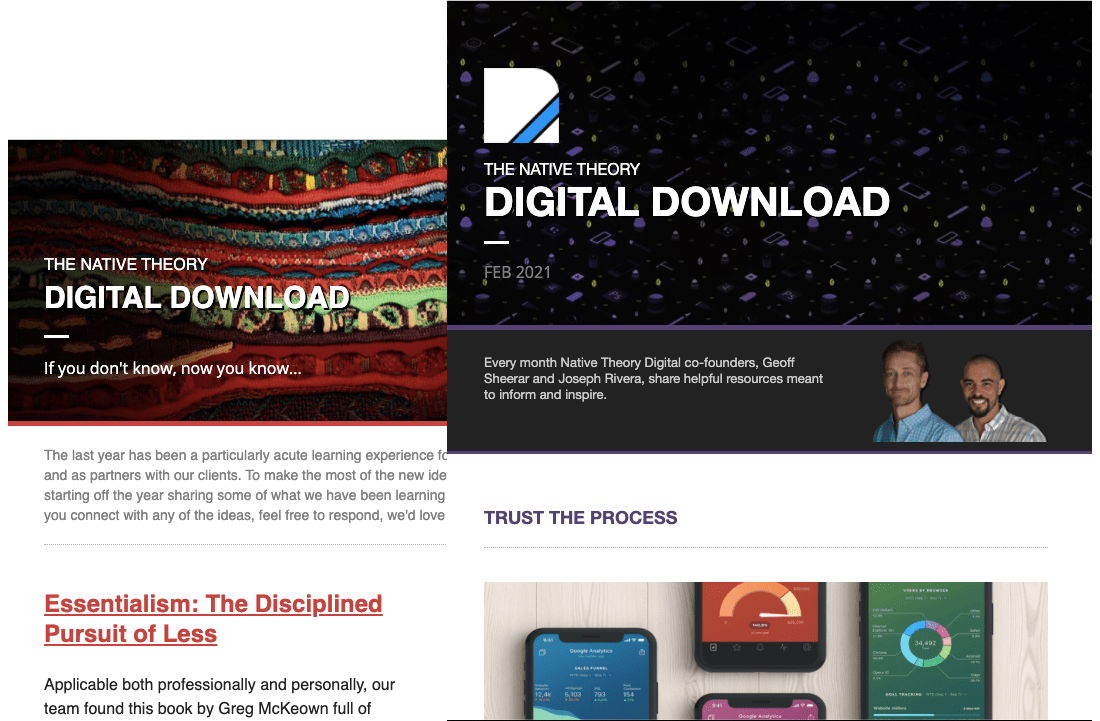What is a Target Client Profile? (and what isn’t)
The success of your organization is fueled by those whom you serve, and how well you understand your target market directly impacts that success. Among the many methods for better understanding who your ideal customer is, we believe that target client profiles are one of the most effective.
Target client profiles are customized breakdowns of the details of your best clients and/or customers (used here interchangeably). These breakdowns can include anything relevant to better understanding that customer, from basic demographic data, to more nuanced, organization-specific information.
Often overlooked, target client profiles are hugely beneficial, and can help you to think bigger, and effectively focus on the specifics of the types of business you want and most enjoy.
Before we dive in, let’s touch on an important distinction. Sometimes terms like client profile, buyer persona, customer avatar, etc. are incorrectly used interchangeably. These terms should not be used interchangeably.
At Native Theory, we use the term “client profile” to mean an actual organization. Once we have developed a target client profile, we can then create buyers’ personas based on the potential decision makers with the organization profiled to provided added benefits.
The Benefits of Target Client Profiles
The benefits of using target client profiles are numerous. Everything from important areas of marketing development, like custom website design, to important areas of sales, like making the most of vital sales relationships.
Although it can be hard to pinpoint which is the most valuable benefit amongst the entire group, in my experience one of the best benefits is simply getting to better know the clients I work with.
All of the benefits of target client profiles fall within three main categories; relationships, marketing, and sales. Some of these benefits overlap with multiple categories. Each of these three areas within an organization is positively impacted in multiple ways by the implementation of target client profiles.
Build Stronger Relationships
The most important group of benefits that come with using target client profiles revolve around relationships. In a broader sense, seeking to understand your clients as well as can be realistically expected helps to create more than just valuable connections. It allows for the possibility of more personalization of products and services, which people expect more and more of each day. It can also help optimize customer retention, as the profiles can help you be better positioned to know and anticipate the needs of your market, consistently provide value that matches your clients genuine needs, and adeptly address their large and small pain points.
Create Significant Marketing Advantages
Multiple areas of marketing benefit from additional personalization these days. Whether that means within a website, within copy written language, or within the visuals we are presented with. A close understanding of target customers allows for more opportunities to personalize specific components of marketing, including specials, offers, and the kind of information that is shared overall. Target client profiles can greatly help with anticipating and answering common questions, as well as segmenting a market overall, which not only can aid in the planning of marketing campaigns and content creation, but also in search engine optimization and keyword research, including that for paid ads.
Optimize Sales Efforts
Target client profiles advance the sales process by providing a better understanding of the potential leads before they come in, informing the members of the sales team how to better guide leads to convert through the sales funnel. Knowing more details about who these leads are also greatly adds to the quality of interactions as they begin to interface with your organization. These details also can inform the product and service development process, providing more details into what could comprise the best solution for many of your best customers.
Enjoy Your Work More
There is an argument to be made that the more closely an organization aligns with what you want to focus on and how you prefer to work, the more fulfilling you will find that work. Target client profiles provide a path that can guide you toward honing this alignment and achieving a higher level of fulfillment.
Developing Target Client Profiles
At Native Theory we believe in a balance of the broad and specific, the clear and the nuanced. These angles contribute in giving us a more complete picture of whom we are dealing with, so we can most effectively communicate, understand, and serve their needs.
Our approach to target client profiles is based on four fluid steps:
- Defining
- Gathering
- Drafting
- Communicating
1. Defining
The first step in developing target client profiles is to clarify the details of exactly what you want, which can include characteristics from customers that exist and ones who do not yet.
Core Considerations
- Who would you like to do business with?
- Who would like to do business with you?
- Which clients have been best to do business with so far?
- Which customers have the best profit margins?
- Which clients have the shortest sales cycles?
- Which customers are most fulfilling to work with?
Get a clear picture of what this ideal would look like and begin to consider what information you need to best understand this person. Opinions conflict in which information is most important to gather about target client profiles. Some say to stay brief and limit the information to only the highest level demographic criteria, and at the other end of the spectrum others go to ridiculous depth with infinitesimal levels of detail.
Core Criteria
We break down the core criteria that we collect within our target client profiles into the detailed information with whom we would like to work. Examples include:
- Industry/Vertical
- Years in Business
- Employee Headcount
- Client Goals
- Budget
- Geography
- Challenges
- Sales Cycle
- Technology Tools of Choice
- Software Platforms
2. Gathering
The gathering stage of developing client target profiles can be daunting, but if you have gone through the defining phase to get down to the most relevant details of who you were targeting, it should be straight-forward.
Whatever you have concluded is the most valuable information to collect about your target market will determine which are the best methods and tools to gather that information. As this information can be both qualitative and quantitative, it is also helpful to consider where to collect it as it is gathered.
Your choice of methods and tools will also be influenced by your company, your team, the industry you are in, and the type of products and services you provide.
Analyze Your Data
Depending on which digital platforms you use, conduct a review of their data to find basic information of what is happening with your brand and its market now. This could include data on website analytics, SEO performance, and direct marketing performance, like social media and email marketing. Better understanding what is already going on helps you better guide what’s next.
Research the Ideal
Of all the targets that you have come up with, what do the ideal targets look like? Consider hypothetically who would be a dream client, what that person would be like, the type of organization they would have, and do some basic research into that hypothetical profile, following the parameters you set in the defining stage.
Get Input from the Sales Team
However big or small your sales team is, they are on the first main point of interaction with all of your leads, whether they turn into clients and customers or not. Even if it just means you and another person, your sales team is a hugely valuable source of information as to what your target client profiles like, don’t like, react to, etc. Regardless of its size, engage with your sales team to gather whatever pertinent information you believe, and they believe would be most effective to know about the target client profiles.
Interview
Perhaps the most effective way to gather valuable information about your target clients is to speak directly to your present best clients. Interviews are a fantastic method because they can lead to all types of helpful information coming to light that may otherwise have gone overlooked. Interviews can also offer the opportunity for more nuanced answers to the questions you are asking.
Survey
In lieu of interviews, surveys can also be highly effective. We recommend that you carefully choose your questions as it will not be a personal interaction. Also consider limiting your surveys to a reasonable number of questions, and consider sending out multiple shorter surveys, instead of one long survey, in order to maximize the amount returned.
Create Case Studies
Case studies can be helpful in getting the information used for target client profiles, because they offer the opportunity to break down specific business experiences into the main components of what worked and didn’t work. Seeing these details laid out clearly can sometimes simplify the decision-making process when considering who are the best clients and why.
Pro Tip – Go through Competitor Reviews
We recommend also taking a look at the online reviews of your competitors, in order to see what their markets are saying. Finding out the specific positive points and pain points that the members of their markets have not only experienced, but voiced, can help to color in more specifics of what would make the best target client profiles.
Recommended Gathering Tools
Choose the tools that work best for you and your team when you are developing target client profiles. Maybe you use software for CRM or POS that would make sense for this. Here are a few of our basic tools of choice:
- Google Docs, Google Sheets – for fleshing out ideas, collecting information, and creating the profiles.
- Gravity Forms, Survey Monkey – for gathering survey information
- Google Drive, Dropbox – for organizing all information and files in a place that’s shareable and easily accessible
3. Drafting
The final step in developing target client profiles, creating them, is where everything comes together. How you utilise all the information you’ve first clarified and gathered depends on what is of most value to you.
Draft Your Profiles
A majority of our clients find developing 3-5 profiles to be most beneficial, but we have often seen cases with hyper-specialized companies that find 1-2 sufficient. These can always be expanded on in the future, and should be added to and updated on a regular basis to keep them accurate. Your profile drafts should include the most salient points collected through each completed phase of defining and gathering.
Consider the Conversion Process
Keep in mind the standard conversion process of your organization when it comes to working with leads to onboarding new clients, including the individual stages of your particular sales funnel. Position your target client profiles to be represented through each stage of your sales funnel, so you aren’t just considering the profile on its own, but within the proper relevant context.
Lay Out the Information
There are options and templates available online for laying out the information in the way that makes the most sense to you and your team. We prefer laying out this information in a basic spreadsheet using Google Sheets. We set a tab for the main stages of the sales funnel (awareness, interest, desire, action), and on every tab is a column dedicated to each profile and a row for each piece of information. When the information is laid out in a system that works for you, it will get easier to analyze and mold the information.
Institute a Grading System
Implement a simple grading or scoring system that can be used to evaluate potential leads that could become customers. These grades can be based on different criteria within each profile and offer a simple way to represent how well that potential client measures up in that category. With grades established, it is easier to compare new potential clients to each other.
4. Communicating
Share and Collect Feedback
Once you have working drafts of your personas, share them and get feedback from members of your organization, particularly the marketing and sales teams. Ensure all key parties are on the same page, and any valuable feedback for polishing the drafts further is collected. This feedback is critical to not only continue to improve the profiles, but to engage these core teams for better communication and inform many of their internal and external efforts, from sales copy to strategic pricing.
Set a Time for Review
From there, set a date for future reviewing. Target client profiles should not be written in stone, but seen as fluid documents to be reviewed and updated on a fairly regular (semi-annual, annual) basis.
Straightforward & Hugely Beneficial
Think big!
The benefits of implementing target client profiles make developing them too attractive to ignore, particularly when putting them together is fairly clear-cut and straight-forward. Growing better aligned on multiple levels with those clients with whom you work can be fulfilling in itself, in addition to all the other benefits.
If you take this on, make it your own. Be bold. Consider the big picture and the ultimate vision of who you want to work with. Get as many details as make sense for your industry and what you do. Break things down in ways that are conducive to how you think. Keep your frequency of reviewing and updating at a pace that works best for you.
Good luck!
If you have questions, reach out to us to discuss.



